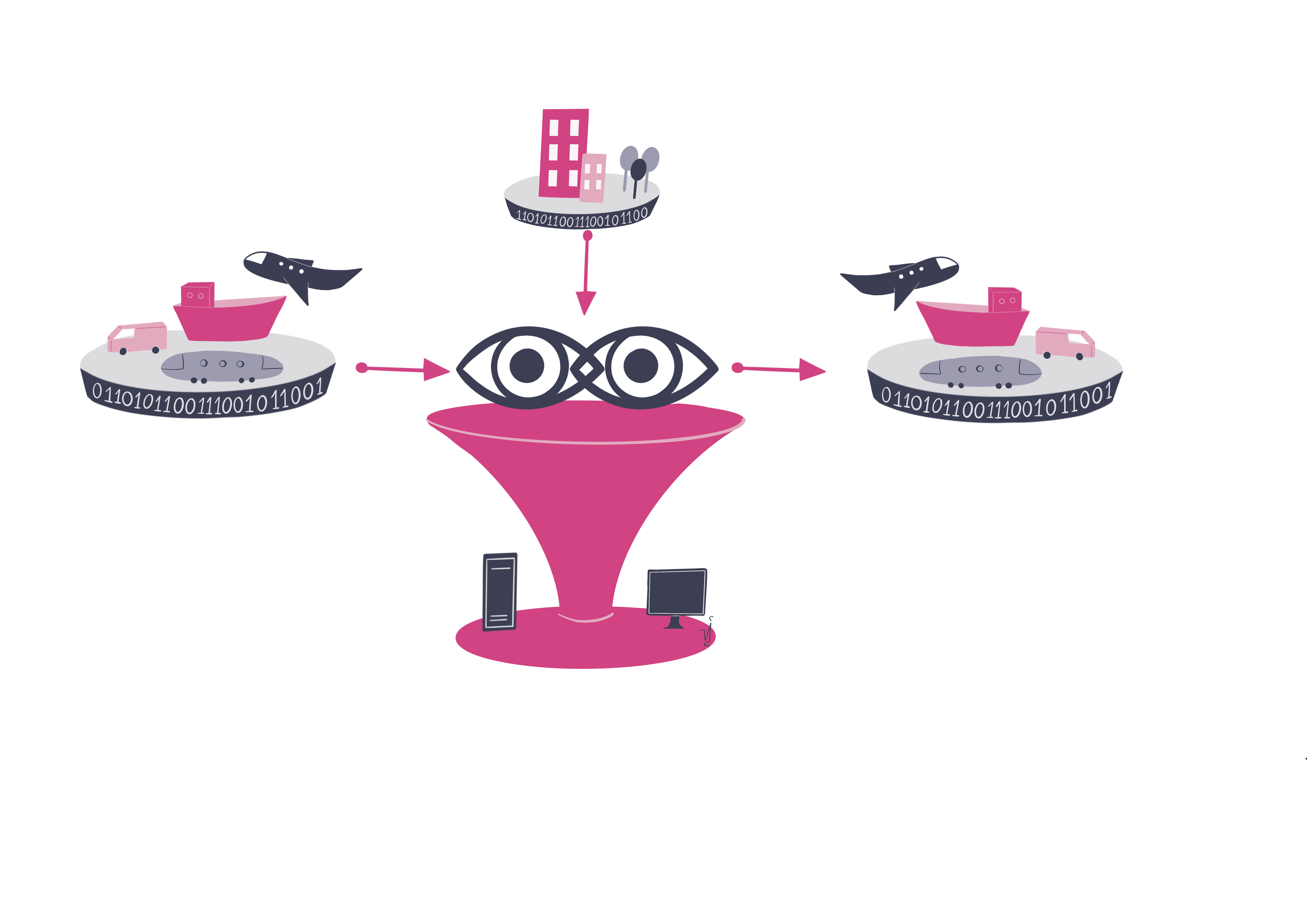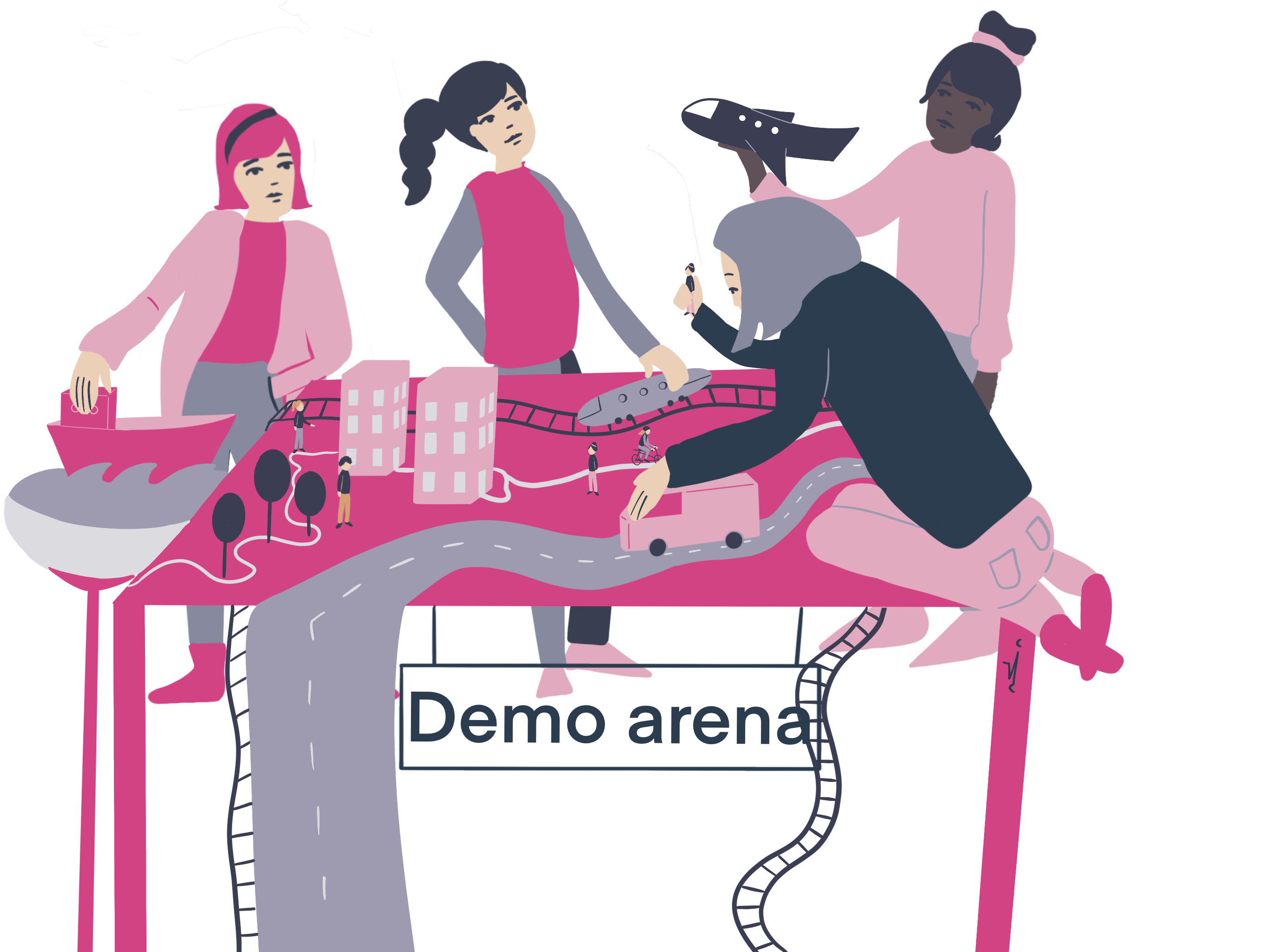4. Digital ecosystem innovations in action
by Mikael Lind, Research Institutes of Sweden (RISE) and Chalmers, Jan Bergstrand, Swedish Transport Administration, Sandra Haraldson, RISE, Kenneth Lind, RISE, Eddie Olsson, RISE, Annica Roos, Swedish Transport Administration, Mikael Renz, Swedish Maritime Administration, Cecilia Strokirk, RISE, Kristine Bull Sletholt, Swedish Transport Administration, Anna Björkman, CLOSER, Kenneth Carling, Dalarna University, Gunnar Ivansson, LearningWell, Mathias Karlsson, Kvarken Ports Umeå, Umeå University, and RISE, Patrik Rudolfsson, Kvarken Ports Umeå
Smart Maritime Network published an abriged version, see https://smartmaritimenetwork.com/2021/09/06/a-federative-approach-to-multi-modal-transport-integration/ The executive summary of the article has been released by The Loadstar (they see https://theloadstar.com/a-digital-ecosystem-supporting-sustainable-multimodal-supply-chains/
Transport is a global phenomenon with regional and local impacts. It involves a multitude of actors, and today there is increasing pressure for transport chains to be environmentally sustainable, predictable, seamless, and cost-efficient. An end-to-end transport most often actually engages multiple transport modes involving visits to various transport nodes. This then requires a high degree of collaboration between the involved actors both within and often across national borders. There is a need to better synchronise transport practices. Big hopes are being placed on digitalisation as an enabler and means for integrated and sustainable performance along the multi-modal supply chain. To do this requires informed decisions on what changes are needed and how they should be made. Before implementing changes, there is a need to reflect on and experiment with the available options to ensure that the desired effects are both feasible and effective, both for the individual organisations and entities involved and for the ecosystem as a whole. Engagement of the multitude of stakeholders is particularly important. Drawing from experiences derived from the ecosystem innovation arenas (living labs), initiated under the European financed FEDeRATED project, this article provides some observations on how to pursue digital innovation in transport ecosystems.
Introduction
Digitalisation challenges many of the existing practices that have emerged over years. One such area is logistics and transport where a lot of effort is now put into establishing interoperability between systems and (local) information sharing communities[1] with agreed connectivity. Digital solutions are expected to provide connectivity along the global supply chain thereby enabling new patterns of interaction as well as seamless transport that is sustainable, efficient, and resilient. Digital data sharing is considered both as a means for enhanced capital productivity for the involved transport actors and providing a greener transport system[2] responding to the needs of society.[3]
Digitalisation can be seen as an enabler for ecosystem innovation by steering the multiple parties towards co-development in making appropriate changes to their practices to be better aligned. To do this requires a shared common object of interest, being an agreement on which standards and design principles are to be used to empower the interaction among the involved parties. In the European initiative on establishing a federated network of platforms such design principles have been defined and are now being validated within the two CEF-projects FEDeRATED and FENIX. Those principles cover plug-and-play allowing a participant to register and connect with their solution/service provider of choice, the use of technology independent infrastructure services for seamless, secure, safe, and compliant trade flows, reaching economies of scale and network effects with standardised protocols through a network of platforms and peer-to-peer solutions, and governance rules for trusted, safe, and secure data sharing.[1] However, before putting these principles into action in an operational and interoperable setting, there is a need to ensure that the desired business effects will arise. An arena of demonstration and reflection needs to be established among the involved parties. Within FEDeRATED this is being done through the adoption of a living lab approach[2] gathering different parties that share a common object of interest (figure 1). Within FEDeRATED, participants from several European countries including Sweden, Spain, The Netherlands, Italy, Finland, and Luxemburg, and several international organisations such as IATA are participating in the task of validating the principles that have been established.
In this article some of the living labs being pursued in a Swedish setting form the basis for exploring how digital ecosystems may be pursued.

Enabling seamless transport by connected transport nodes
Seamlessness in transport is an important ingredient for sustainability, for example by avoiding unnecessary waiting times, thereby contributing to high utilisation of used infrastructure, and for providing customer value. To enable seamless and sustainable transport, an emphasis is being put on empowering transport nodes to become more integrated in the transport chain, taking sustainable ports[1] as the foundation for conceiving generic characteristics of transport nodes. Several types of nodes are in focus, including airports, combi terminals, (sea)ports, yards, railway stations, but also warehouses and logistic centres. Naturally, different transport nodes are driven by different logics dependent on factors such as ownership and actor engagement. A transport node would be operated differently if it is intended to service only one client, such as in the case of a company warehouse, or if the transport node engages multiple organisations in its value production aimed for multiple clients, such as in the case of a sea- or airport.
Regardless of the underlying organisational logic, a transport node cannot operate in isolation (see figure 2). It is highly dependent on what is happening outside its scope of operations to assure that its resources and infrastructure are used optimally. The required business intelligence needs to be derived from:
- consuming data on the progress and disruptions occurring related to the movements made by transport operators and at previous transport nodes expanding the planning horizon for the transport node;
- providing transport operators with the means to optimise their approach to the transport node, and
- providing the means for the transport coordinator to inform their clients on the progress and forecasts associated with the goods and people that are being transported, thus providing a basis for onward planning.
Digitalisation offers capabilities for transport nodes to be highly integrated in the transport ecosystem. This concerns supporting both the coordination of physical operations, and the provision of fossil-free energy, both for sustainable node operations and for fuelling episodic visiting carriers, and as an enabler of the green conversion of the transport ecosystem, but also to seek new services opportunities. At the core, collaboration enabled by digital interaction and data streams will expand the transport node’s event horizon and improve situational awareness providing opportunities for optimising resource and infrastructure utilisation.
Infrastructures for digital interaction in multi-modal transport chains
Digitalisation of transport nodes and digital interaction in multi-modal transports requires infrastructure support (such as coordination of information in interoperable systems). Currently, operational systems and platforms exist for more-or-less limited purposes around transport nodes of any type. Platform vendors offer means of integrating to other operational systems, but this is a slow process that does not easily support new ecosystem actors and the exploration of new business models / use cases. Furthermore, the operational systems are typically not suited towards adding different types of sensors required for digitalising the operations around multi-modal transport nodes.
To support ecosystem innovation in multi-modal transports, the operational systems need to be complemented with data-agnostic platforms tailored to collect data from different sources and to test new solutions in a fast and flexible way. Besides data from operational systems like Port Management Systems and Terminal Operating Systems, there is a multitude of different sensors providing data for digitalising key parts of operations, such as RFID readers, cameras with image processing algorithms, GPS, IoT sensors for temperature, humidity, etc., sourced from different physical entities. Based on available data, prototype solutions can be built for different use cases, like the automation of recurring events at a transport node, end-to-end supply chain visibility, etc. Learnings from the prototype solutions can then be used for maturing requirement specifications for sourcing operational solutions in later phases.
Besides facilitating the test and demonstration of data sources and use cases in a neutral setting, business models and other incentives for sharing data are crucial in digital interaction and can be explored in this type of data-agnostic platform (figure 3). Common ecosystem needs and capabilities can be identified, such as new standards, processes, etc. Security threats can be explored and system mechanisms taking care of identified threats can be verified.
One example of a data-agnostic platform supporting ecosystem innovation in multi-modal transport chains is Deplide that is being developed by RISE and used within FEDeRATED. Deplide is based on solid experience from similar platforms in several large-scale projects within the maritime sector[1] adapted to more generic multi-modal transport needs. It has been developed primarily to support data sharing around a transport node, where main events along the supply chain occur. It integrates technology and solutions that are available as open-source and will itself be published as open-source.
Different types of data providers can be connected to Deplide, including temperature sensors, RFID readers, Port Management Systems, Terminal Operating Systems, etc. In a similar way, different types of data consumers can be connected, including front-end applications and services. These connection capabilities make Deplide ideal as a platform for collecting different types of data, aggregating, and analysing streaming data. Front-end applications and services can be built on top of the platform to explore different use cases around multi-modal transport.
Data sharing and distribution of information in “live time” is central to collaborative decision making and increased supply chain visibility. Data sharing and distribution of information is facilitated by interoperability between systems that contain relevant data. This type of interoperability builds upon standardisation of things as communication protocols, security mechanisms and data formats.
The data that needs to be shared are typically concentrated around events during the transport process; it could be a ship arriving at a port, an airplane arriving at an airport, or cargo that is transhipped at a logistic centre. A flow of events with associated data makes up a so-called event stream. Deplide is developed to manage event streams using Apache Kafka[2], an open-source distributed event streaming platform used by thousands of companies for high-performance data pipelines, streaming analytics, data integration, and mission-critical applications. Deplide is currently being developed as a platform for digital interaction in collaboration with several ongoing ecosystem innovations around multi-modal transport nodes.

Ongoing ecosystem innovations – some examples from FEDeRATED
To support seamless transport, approximately 20 living labs are being conducted within FEDeRATED, addressing several modes of transport and putting focus on multi-modal concerns capturing the value of enhanced transparency and data sharing beyond the single organisation. The living labs focus upon how information sharing and collaboration among involved parties along the transport chain for selected events within (including a section of) a transport corridor may be empowered by digital technologies. Some of the living labs being coordinated by Sweden are captured in the table below.
|
Living Lab Aspect |
Sustainable Inter-Modal Chains (SIMC) |
Rail-road Terminal CDM |
Transparent Transport: City of Helsingborg |
Multimodal Information Sharing III |
A data-sharing case for SME, last- mile delivery actors |
RFID in rail |
|
Overview/ Purpose/ |
Data sharing to ensure visibility and seamless integration of information between the actors involved in the transport chain. |
Demonstrate the concept of Collaborative Decision Making (CDM) at two multi-modal terminals. |
Coordinate transport collaboration through data sharing around the city’s goods and traffic flows from purchased products to a school. |
Retrieve and share important logistics data to increase transparency and efficiency in global supply chains. |
Engage in and identify the reaction of one of the actors within last-mile transport in a federated data sharing system. |
Consolidating and scaling up the current RFID solution for multi-modal transport (including rail) to a European level. |
|
Type of involved actors |
Ports, Municipalities, Transport administration, Shipping companies, IT service providers, Research Institute |
Science park, Research Institute, Regional developer, Logistic operators, Goods owners, Intermodal terminals, train and truck operators |
City, Transport administration, suppliers of goods to the city, the suppliers’ carriers |
Science park, Research Institute, IT providers, Manufacturers, Maritime & Transport Administration, Logistics operators |
University, Transport administration, Shippers, subcontracted last-mile carriers |
Transport Administration, Consultants, Rail operators, Logistics operators, Rail operators |
|
Business case at focus |
Establish foundations for calculating CO2 emission along the supply chain, Enhanced planning capabilities, Reduced administrative burden |
Improve coordination capacity at multi-modal terminals to increase efficiency and transparency amongst customers and operators of multi-modal transport |
Monitoring compliance in public procurement contracts, Enhanced safety, enhanced cost efficiency, and lowered emissions by reduction of the amount and frequency of deliveries |
Increase the performance of the supply-chain and minimise tied equity in export cargo, Lessen implementation costs for connecting parties to a digital infrastructure |
Enhanced business and operational efficiency for subcontracted shippers in last-mile transport |
Reduce administrative time/work in terminals, harbours, shunting yards, etc. Track and trace railway vehicles all over Europe |
|
Key data sources |
IoT sensors, Digitalisation of paper documents and driving reports, Data on (estimate and actual times of) events associated to the multi-modal transport nodes. |
Data on (estimate and actual times of) events associated to rail-road terminal operations as well as data on container status. |
Data on goods and traffic flows to/from the school. |
Data on shipping instructions, waybills, terminal operations, itinerary data from different modes of transport, customs data, etc. |
Delivery and pick-up route data on position and handover time, goods carried per vehicle, financial data on shipping, predicted orders, fleet utilisation. |
RFID readers (Radio-Frequency Identification); What, Where, When, Why, |
The living labs outlined in the table illustrate some of the needs and challenges involved in multi-modal transport spanning over several transport nodes, each having its own ecosystem of involved actors. The identified challenges and business cases at focus highlight the data sources and types of information that need to be shared among the actors to address the challenges. In some cases, only part of the needed data is identified, and additional information needs to be explored during the living lab activities. Typically, this additional information must be obtained through installing new types of sensors or connecting to existing operational systems. To succeed in their ambitions, the living labs require a data-agnostic platform tailored to collect data from different sources and to prototype new solutions in a fast and flexible way. Learnings from the prototype solutions developed during the living labs can then be used for sourcing operational solutions supporting the transport node maximising its value contribution as part of multi-modal transport chains.

Closing summary
Digital innovation in ecosystem settings is a challenging task. It is crucial to define a common object of interest as well as each of the participants’ needs so that they see the value of taking part in the innovation effort. There is a need for reaching agreement on how each participant needs to act, and which standards to utilise in emerging interaction patterns, before making appropriate implementations and changes at each end. Business models, on ecosystem as well as for each participant, interaction patterns, and supporting digital infrastructures need to go together.
To pursue ecosystem innovation in authentic settings, arenas that support participants in joining forces to investigate and overcome common concerns need to be established. Within the frame of FEDeRATED those arenas are the living labs. In the case of FEDeRATED the purpose has been to explore which digital interactions/collaborations are necessary to implement to support seamless transport. As one driver for enabling action and reflection among the participants of the living labs, a data-agnostic data sharing platform is being used in several of the FEDeRATED living labs to experiment, demonstrate, and elicit requirements for forthcoming implementations (figure 4). Such a platform has (at least) the following characteristics:
- Flexible collection and transformation of data from different data sources such as different sensors providing data for digitalising key parts of operations, as well as operational systems like Port Management Systems, Terminal Operating Systems, etc.
- Flexible access to collected data from different front-ends and applications exploring prototype solutions for important use cases addressing the needs of the participating actors.
- Efficient coordination, search, and manipulation of data flows captured in real-time from different data sources, so-called event streaming.
- Durable storage of collected data for later retrieval.
- Flexible connection to analytics and visualization frameworks in real-time as well as retrospectively.A focus on short turn-around time for changes in the platform and development of connectors to integrate with existing systems
As multi-modal transport is a distributed and self-organised ecosystem, change cannot be pursued by one single actor. To reach successful outcomes and to contribute to a better world, stakeholders need to meet and co-design solutions that all participants have incentives to make their contribution to. The living labs under FEDeRATED are providing that meeting place.
[1] See e.g. the definition and validation of PortCDM discussed in Lind M., Watson R.T., Ward R., Bergmann M., Bjørn-Andersen N., Rosemann M., Haraldson, S., Andersen T., (2018) Digital Data Sharing: The Ignored Opportunity for Making Global Maritime Transport Chains More Efficient , Article No. 22 [UNCTAD Transport and Trade Facilitation Newsletter N°79 - Third Quarter 2018] (https://unctad.org/en/pages/newsdetails.aspx?OriginalVersionID=1850) and the emerging discourse of Maritime Informatics at www.maritimeinformatics.org
[1] Lind M., Haraldson S., Carson-Jackson J., Gardeitchik J., Singh S., Zuesongdham P., Morton R., Pettersson S., Pernia O., Larsen S.E. (2021) Ports as multidimensional hubs, in M. Lind, M. Michaelides, R. Ward, R. T. Watson (Eds.) Maritime informatics: Additional Perspectives and Applications. Forthcoming, Heidelberg: Springer
[1] www.dtlf.eu
[2] https://www.ri.se/sv/berattelser/living-labs-kortar-tiden-fran-ide-till-implementation
[1] Lind M., Becha H., Simha A., Bottin F., Larsen S. E. (2020) Digital Containerisation, Smart Maritime Network, 2020-06-18 (https://smartmaritimenetwork.com/2020/06/18/containerisation-standardised-the-physical-digital-standards-must-follow/)
[2] Lind M., Alvarado J.L., Haraldson S., Mulder H., Nykänen L. and Piccoli G. (2021) Digital data sharing for green transport - a FEDeRATED approach, 3/6-2021, The LoadStar (https://theloadstar.com/digital-data-sharing-for-green-transport-a-federated-approach/)
[3] Lind M., Watson R., Chua C. P., Levy D., Theodossiou S., Primor O., Picco A. (2020) A Primer for a Profitable and Sustainable Maritime Business, Smart Maritime Network, 2020-09-09 (https://smartmaritimenetwork.com/2020/09/09/prime-considerations-for-shipping-success/)

- Hits: 3495
